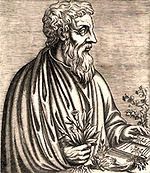Hello internet! I'm a plant nerd with designs on grad school and one year left on my BSc in evolutionary biology. My plan is to write on various topics of interest to me in plant biology, with a focus on my areas of specialty: systematics and comparative development. The goal is to improve my science writing and natural history chops, hopefully while being slightly interesting.
I should post a real article within a few days. Stay tuned!
(My title, by the way, is cribbed from
this excellent, if outdated, book by E.J.H. Corner.)






